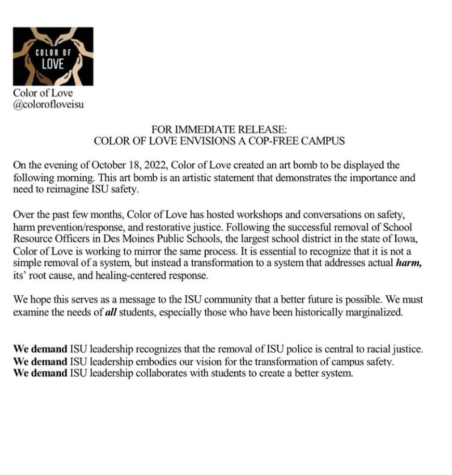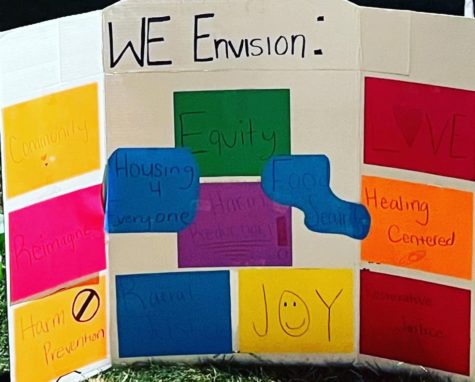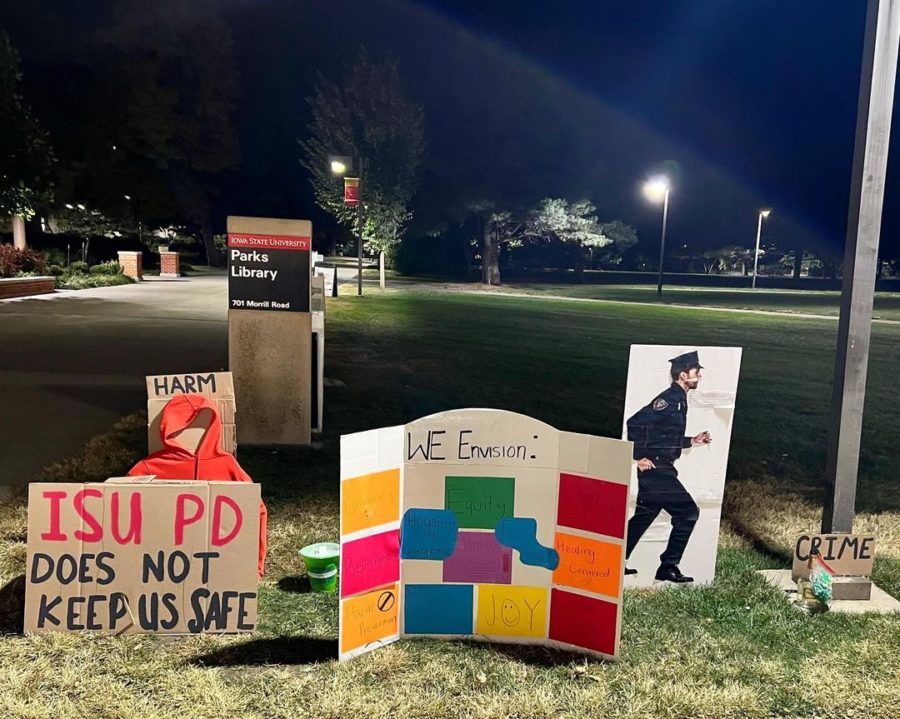‘It can be successful’: Students demand cop-free university
Color of Love’s art-bomb activism showcased the issues they see in the current campus safety model that addresses crime rather than harm.
The student organization Color of Love is calling for Iowa State leadership to collaborate with students and remove the police from campus.
The organization wants to transform the current model of campus safety from one that centers around cops to one that focuses on harm restoration and prevention while centering on racial justice.
After holding a demonstration, the students released a statement detailing their envisions, and they are currently surveying students’ experiences with Iowa State police and campus safety.
Since its start last year, Color of Love has built a community with other students of color through opportunities for student-based organizing with departments such as advocacy, culture, communications, education and finances.
Removal of cops
In the organization’s release statement, ‘Color of Love Envisions a Cop-Free Campus,’ the organization demanded that Iowa State leadership recognize that the removal of Iowa State police is central to racial justice.

“That sort of statement may be really bold,” said Endi Montalvo-Martinez, facilitator for the advocacy department at Color of Love and a sophomore in liberal studies. “The reason we’re pushing for it is because we know that it can be successful.”
Before coming to Iowa State, Montalvo-Martinez and Lyrics Sellers, a co-facilitator for the advocacy department, were both students in the Des Moines Public Schools system. While there, they assisted in the removal of the School Resource Officer (SRO) program through a racial equity proposal.
“I feel like there’s a disconnect that people think we just want to take cops off campus, while in reality, it’s understanding that it’s a systemically racist structure that you can reallocate resources to something that works for everyone,” Montalvo-Martinez said.
This removal was not immediate and involved reinvesting money previously going to the SRO program into restorative justice positions and practices.
“I think, a lot of times, the narrative has kind of shifted into an anti-police type of message when it’s really a pro-safety thing,” Sellers said.
The message behind the release statement and art-bomb activism is that the organization wants an institution where everyone feels safe on campus.
“The big thing with that is a lot of people don’t get their sense of safety from policing,” Sellers said. “Ultimately, we’ve seen it can happen, especially if it’s something our administration makes it a priority and something that needs to happen.”
Transformative process
Another demand called for Iowa State leadership to embody the organization’s vision for the transformation of campus safety.
The organization’s survey considers lived experiences to see how to better address harm and safety.
“With ISUPD, I know there’s some mentions of racial tension,” Montalvo-Martinez said. “[People] feel like in interactions with the police offices where they, themselves, have been victims of sexual assault, felt like they couldn’t talk to the ISUPD or have friends who are victims of sexual assault that did talk to ISUPD and nothing happened from it and [ISUPD] weren’t listening the entire process.”
Montalvo-Martinez explains that these experiences show the disconnect between the reality of student experiences and what ISU leadership thinks is actually happening.
In the survey, a lot of people support reinvesting money into better public safety measures such as preventative services and mental health services.
“There’s only a handful of therapists on campus for students seeking counseling services, and, even then, they only get a handful of free sessions,” said Briana Flores, treasurer of Color of Love and a freshman in pre-business.
Counseling Services currently offer six free sessions for students.
Flores hopes that investing more money into this service will allow for more therapists to be hired so that students will have better access to help for their mental health and have more sessions available.

Along with transformation through counseling services, the organization’s art bomb included a tri-fold that listed other ways to create a safer campus for students, including harm prevention, centering healing, housing for everyone and food security.
The art bomb also differentiated between harm and crime. Harm, Flores explained, is something that happens during a personal interaction, and crime is something society defines.
In the art bomb, the possession of the bottle of alcohol and bag of weed were actions the police officer defined as a crime, while the harm was something the student was facing that was being ignored by the police.
The organization wants to use a restorative justice model to tackle this issue of harm that goes unaddressed. In this model, there are two tiers: prevention and restoration.
Within the primary tier of prevention, programs need to be implemented to prevent issues such as sexual violence from happening, according to Montalvo-Martinez.
The second tier of restoration focuses on repairing harm that has already happened.
“I feel like that’s something that’s lacking from the ISU police department because if you look at their job description, their only role is to charge crime and enforce local, state and federal law,” Montalvo-Martinez said. “Looking at their recent crime log they publish, the vast majority are alcohol-related.”
Iowa State Police Department’s perspective
“Community outreach is extremely important to our team and we have taken several steps to build stronger relationships with members of the Iowa State community,” Michael Newton, chief of Iowa State’s Police Department, stated in an email to Iowa State Daily.
Among these steps, Newton stated is the creation of a student advisory board to understand the needs of the student body, having mental health advocates on the team and the formation of the Engagement and Inclusion Officer (EIO) team, which partners employees and students to focus on creating an inclusive campus.
Newton said in the email since Iowa State is a Regent institution, it is required to maintain a public safety department, according to the Iowa Board of Regents policy.
“I’ve reached out to the students to schedule a meeting to discuss our efforts and listen to their experiences, concerns and suggestions related to public safety on campus,” Newton stated in the email.
Collaboration with Iowa State
The final demand made in the organization’s release statement is for Iowa State leadership to collaborate with students to create a better system.
Sellers explains it can be frustrating to take on work to create an equitable environment while coming to the university to learn.
“I think really just ensuring that they are doing their part and doing what they get paid for as we’re doing it purely out of passion and the fact that we want to create a better environment for students,” Sellers said.
The students emphasize that this process is not an immediate one but one that is gradual and centered in transformation.
To participate in Color of Love’s survey on campus safety, visit this form.
Your donation will support the student journalists of the Iowa State Daily. Your contribution will allow us to purchase equipment, send our student journalists to conferences and off-set their cost of living so they can continue to do best-in-the-nation work at the Iowa State Daily.


















Edward Miller | Jun 21, 2023 at 12:23 pm
That look interesting!
TIm | Nov 3, 2022 at 10:05 pm
ISUPD and Chief do excellent work. The community outreach is great. I have seen the work done by their mental health advocates and in 2022 they invested even more into that program. The student advisory board continues to advise the department. Maybe these students should join in that effort, Maybe sitting down and hearing all the efforts they are putting in before jumping to conclusions.
Phillip Clearman | Nov 3, 2022 at 4:36 pm
I would hate for this to pass, and then some kind of mass shooting occurs on campus and there be no one able to stop it.
Confused | Nov 3, 2022 at 11:49 am
It seems the chief of police needs to re-evaluate what he considers helpful. He claims steps have been taken to improve community outreach, but fails to mention his elimination of the department’s community outreach officer position. His claims include the creation of a student advisory board (circa 2018?) and the Engagement and Inclusion Officer team (a 2017 rebranding of an already-existing team, according to an April 2018 Daily article). This guy made $205k in 2022. What did he do in 2022 to improve relationships?
I’m not in favor of removing the police from campus, but it seems like they need new and more focused leadership.
Not Confused | Nov 3, 2022 at 9:35 pm
You sound like a bitter ex-employee. I met with their community outreach team recently, and they are well-staffed and helped our organization. Many of the programs are ongoing, and they discussed them. My friend is on the advisory board, and they have enjoyed a great relationship with the PD. Take your confused self elsewhere; many of us love what they are doing.
Wyatt Stucky | Nov 3, 2022 at 7:59 am
After reading the article in it’s entirety, I still believe that the demand to make ISU a police free campus is absurd. ISU is already a gun free campus (unless certain criteria by the individual is met) and taking away a police force would make no sense. The notion of “police are part of systemic racism” is something we hear too often on this campus and this ideology needs to change. A lot of students need to wake up. Not everything needs to become an issue.